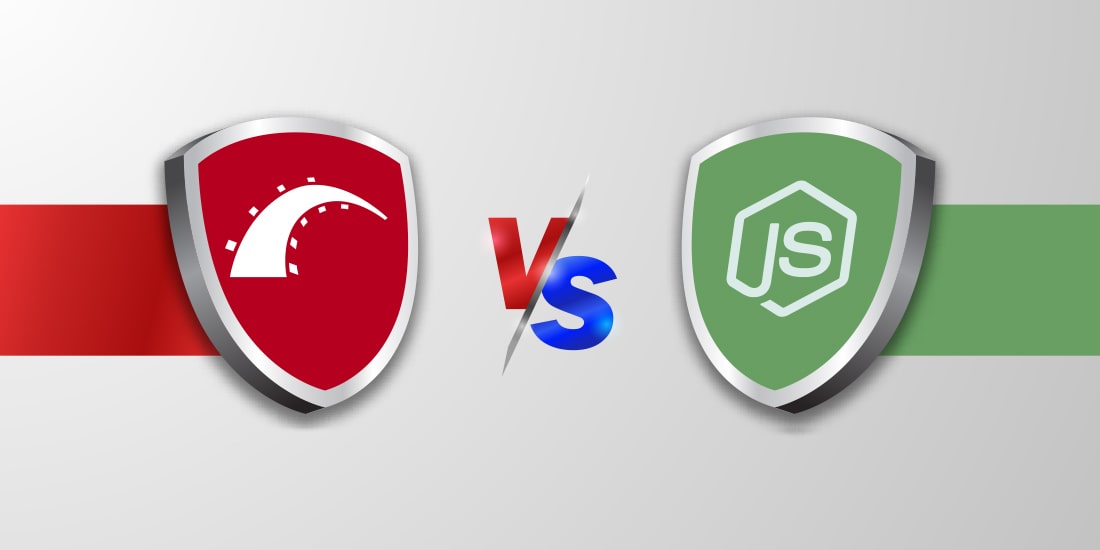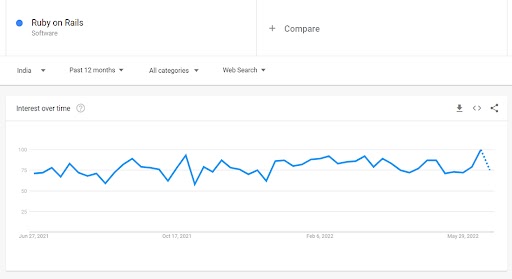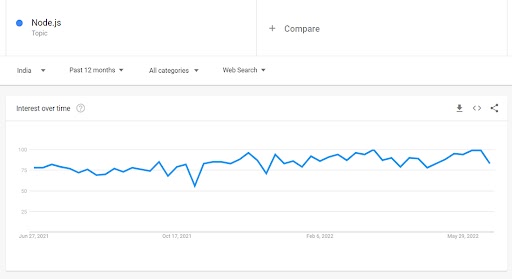Quick Summary:
Quick Summary: A comprehensive comparison of the most prominent backend technologies- Ruby on Rails vs Node js 2025. Go through the aspects, categories, and parameters that will be the deciding factors before choosing the suitable backend development framework for your web app development project. Also, learn what to choose between Ruby on Rails and Node JS.
Table of Contents
Introduction of Ruby on Rails and Node Js
Comparing Ruby on Rails and Node.js is similar to comparing guava and mango. In simple terms, Node.js is an application runtime environment that uses Javascript to write server-side applications. In contrast, Ruby on Rails (RoR) is a framework.
Choosing a front-end tech stack for your website might not be arduous. There are many obvious options like JavaScript, CSS, and HTML5. However, the problem arises when you decide on backend technology. Lately, two of the leading trusted and popular backend frameworks in today’s market involve Ruby on Rails and Node.js. These frameworks are flexibly adopted by several prestigious and large firms worldwide.
However, to help you understand both frameworks, this guide focuses on Ruby on Rails vs node js comparison. The article lists an unbiased comparative study of both frameworks under six major parameters around businesses. By the end of the article, you will be able to see a clear difference between Ruby on Rails and Node.js to help you select the one that fits your business needs. Let’s find out what these frameworks have in their pocket without further ado!

Node.Js Overview
First, Node.js is a runtime environment, not a language. It allows users to transform client-side code to server-side code. Typically, the node changes JavaScript into machine code which the hardware can process within a click. Based on the Chrome V8 Engine, Node.js is one of the fastest engines in the market. It makes a major contribution to run time’s peak conversion speed.
Ruby on Rails Overview
Ruby on Rails can be described as a website development framework. Rails are designed to help manage internal logic, routine, data computing, etc. Rails/RoR is the best option for beginners as it readily builds and executes excellent and functioning full-stack websites and web apps. The best part is that Ruby on Rails (RoR) is popularly known for its super-level speed and code efficiency. In simple terms, what Java does in dozens of lines, Ruby does it within 5-10 lines.
Ruby on Rails vs Node js Statistics
Below are some of Ruby on Rails vs Node js market usage statistics as a backend technology framework. Take a look at the core statistics of the two major, trusted frameworks in the market.
Ruby on Rails Market Share

- RoR holds over 47.5k stars and 2.5k watchers on Github.
- Computers Electronics and Technology held one of the largest/major project shares by 6.64%. They are based on RoR among the rest of the industry verticals.
- As per SimilarTech, there are 394,000 websites in the market that RoR powers.
Node JS Market Share

- Under the StackOverflow Developer Survey Report 2020, Node.js is rated as the most loved tool by 66.8% of developers.
- In the same year, 51.4% of developers considered Node.js the most preferred tool.
- Typically, 85% of developers use Node.js for web application development, while 43% use it for regular enterprise-grade apps.
- StackOverflow notes a considerable increase in Node.js discussion over the past decade covering almost 3.5% of questions related to Node.js. This indicates its increasing popularity.
Ruby on Rails vs Node js Comparison Parameters
While these parameters must not be a killer factor for any projects, it becomes highly significant to consider each one while building large, small, or complex projects. Let’s look into Ruby on Rails vs Node js performance, scalability, application architecture, execution, libraries, and Readability of Code.
Want to use our Node Js development services to perfect and scale your current application?
Hire Node js developer from us to explore better efficiency and performance to achieve desired results with fewer resources.
How does RoR differ from Node js in terms of performance?
Speaking of Ruby on Rails, there is absolutely no doubt that RoR is known as the fastest or most performant backend framework in the market. RoR slows down its applications under certain circumstances as a garbage collection and interpreted tool. However, these situations are quite rare. It occurs only when the traffic scales up considerably.
On the other side, Node.js gets the non-blocking and asynchronous features from Javascript, it builds an ideal environment for small (micro-operations) tasks that do not cause any impact on the main application thread. In terms of performance nodejs, it speaks volumes. Add-ons: The V8 JavaScript engine makes multitasking easier, more efficient, and seamless at lightning speed.
How does Node js differ from RoR in terms of performance?
Compared to the rest of the backend solutions, Node.js processes tons of requests simultaneously. The best part is that many leading tech companies are heading toward choosing Node.js due to its phenomenal performance. After migrating to Node.js, LinkedIn reduced its servers from 30 to 3, whereas PayPal’s average response time declined by 35%, doubling their requests every second. Doesn’t that speak enough of Node.js performance?
Our Verdict
In a nutshell, comparing the RoR vs Node js, Ruby on Rails can build efficient web apps by offering a genuine and satisfactory performance with it in most cases. All you need to ensure is to adhere to the development standards and sit back and look at how smooth and seamless the rest of the procedure is.
Ruby on Rails vs Node.js Scalability
Is Node JS More Scalable than Ruby on Rails?
Speaking of RoR, it is completely possible to scale with Rails. However, the procedure needs you to invest maximum resources as compared to the rest of the leading backend frameworks. There was a time when hundreds of questions were posed on Ruby on Rails scalability when Twitter switched from it. Scaling quickly on the platform sometimes brings up issues to the table due to Ruby’s poor concurrency and insufficient memory management. However, popular apps like Airbnb and Shopify are sufficient to display the capacity and scalability of RoR in handling higher traffic.
Every framework puts quite an effect on the app’s scalability. Hence, choosing the right framework becomes imperative. There is no doubt that Node.js builds uncompromising and highly scalable apps. The event-driven model and non-blocking I/O can manage multiple concurrent requests. RoR’s event loop mechanism also enables the server to process a maximum number of requests. The best part is that Node.js has excellent compatibility with microservices by breaking apps into tiny parts. This way, allocating tasks among distinct development teams becomes easy, thus building applications more scalably and quickly.
Our Verdict
Yes, Node.js is better than Ruby on Rails when it comes to the scalability of apps. Node.js processes a mix of Node clusters and workers and allows developers to expand the app’s features compared to using Ruby on Rails as the server processors limit the workload.
Still wondering why Ruby is the best programming language for your enterprise?
Hire Ruby on Rails developer from us and they will help you verify the project scope and obtain a valuation.
Ruby on Rails vs Node.js App Architecture
Ruby on Rails or Node js, which one has better web app architecture for the enterprise-grade app?
Speaking of Ruby on Rails, it strictly follows the Model View Controllers (MVC) architecture. The model layer is where you put the data logic. While the view looks after the application’s front end, the controller is accountable for the flow.
Due to the convenient separation of concerns, the architecture enables easier decoupling and testing at the next stages. RoR follows the convention-over-configuration principle. In simpler terms, Developers need to do less legwork because the framework makes some decisions independently.
Now, it is highly significant to avoid all the strict enforcement of guidelines and architecture while choosing a framework. If you must know, it is always noted that a framework should be treated as a guide, not as standards and methods. That said, Node.js supports good architecture.
It leverages single-threaded event loop architecture, allowing it to manage a series/ multiple concurrent requests with higher performance. However, Node.js allows you to use the MVP/MVC architecture pattern, which does not complicate and makes the onboarding and isolating issues in the app codebase easy. Besides this, Node.js builds multiple views for the very same data. It supports asynchronous interaction between several/multiple components.
With async architecture, there are several benefits that you can achieve. Ideally, it
- Makes sure that the development of modules is flexible and faster
- Processes many concurrent requests simultaneously
- Offers excellent performance
- Lowers the time-to-market of applications.
Our Verdict
Ruby on Rails is a clear winner as RoR has a much better way to develop powerful web architecture than JS-powered Node.js.
Node.js vs RoR Execution
Because JavaScript was introduced decades back, Node.js can easily take advantage of all the ready-to-use solutions and experiences that JavaScript holds. However, because the range of possibilities is quite limited, Node.js lags behind most full-scale backend programming languages. Hence, it takes quite a lot of time to find perfect solutions to the problems in terms of execution.
On the other hand, Ruby on Rails is one of the handiest and easiest languages one can use and learn. There is a plethora of tools and syntax that enables faster development and execution.
Ruby on Rails vs Node js Libraries
In Rails, the package library is known as the Ruby Gems. On the other hand, Node.js has a Node Package Manager (NPM) that offers packages and libraries to prevent repetition of coding. NPM and Ruby Gems offer a standard format for building NPM packages with accurate version control and easy installation.
One of the top reasons why web developers prefer and like working with modules is their reusability feature. In other words, you can easily break down a large and complex code into tiny manageable parts. The best part is that both Node js and Ruby on Rails offer packages and modules for this purpose.
Ruby on Rails vs Node js Readability of Code
Let’s talk about the Ruby on Rails learning curve. Generally, Ruby has a great Readability of Code and is super easy to learn. Looking at the huge and active RoR community, individuals can get as much information as required to learn more about the framework from multiple tutorials and courses.
Node.js has quite a short learning curve. The best part here is that it becomes easy for developers to master this framework belonging to different backgrounds like C# or Java. Especially for those with excellent knowledge of JavaScript, learning Node.js is nothing to them. The readability of the code is quite clear and easy. this information curious you for the Ruby on Rails vs Java comparison. know all the aspect.
Key Differences Between Node js vs Ruby on Rails
Let’s quickly explore which one fits best for your product between Ruby on Rails vs Node js.
| Node JS |
Ruby on Rails |
| Node.js is written in JavaScript. It is a runtime environment framework. |
Ruby on Rails is written in Ruby. It is a Ruby-based framework. |
| NodeJS is best for all small-scale projects. You can use it for event-based, I/O, non-blocking applications. |
RoR is well suited for all database-backed web apps that work in meta-programming and MVC patterns. |
| The working node js page load is extremely fast as compared to Rails. Node js is best recommended for building faster applications. |
RoR is quite slower than Node.js. This framework is best for building fast, large-scale, and complex applications. |
| NodeJS is quite easy to install. All you need to do is install some archive files on the system. |
Rails require a lot of work. You need to install tons of stuff and generators. |
| Some companies that use Node.js are LinkedIn, Heap, eBay, Sense, and Medium. |
Some companies that use Ruby on Rails include Airbnb, GitHub, Dribble, Base camp, Soundcloud, Scribd, Shopify, etc. |
| NodeJS offers the facility to build web servers independently with the capacity to manage all the HTTP requests. |
Ruby on Rails must depend on NGINX, Apache, WEBrick, and Cherokee. |
| Developers can use Node JS for both client-side and server-side purposes. |
Ruby is a server-side framework. |
| Excellent market demand. Users of Node.js are rising exponentially. |
Looking at the current market scenario, Ruby on Rails is less popular than Node.js. |
| Node.js takes quite more time while deploy the application. This is because developers here must search for the modules followed by certain instructions to integrate them with the app. |
Compared to Node.js, Ruby on Rails is much faster and lighter. You can perform and execute all your tasks easily. For example, migrating a database will merely take a few commands, and you are done. |
| The learning curve with Node JS is quite less. It is understandable and easy, and flexible for novices. Learning it does not require any prerequisites with or without any prior background. |
Speaking of Ruby on Rails learning curve, learning RoR is easy. All you need to do is to understand the basic attributes. This includes classes, objects, Ruby-level methods, etc. Each of these attributes is highly important and takes considerable time to understand. |
When To Choose Which One?
Primarily looking at the specialty of both frameworks, RoR is better than Node.js for projects that require intense CPU power. Apps built with Ruby on Rails are performant in handling complex and heavy images, videos, and graphics compared to those built with NodeJs because of its single-threaded feature. Looking at the generator scripts, we do not doubt Node’s performance and speed, but it can never beat the speed of Ruby on Rails. App speed is noticeable factor of why use Ruby on Rails.
However, if you want to build a scalable project, choose NodeJS over Ruby on Rails because it has the cluster module architecture. It processes concurrent requests proficiently and is best suited for developing real-time applications. Let us reiterate when to choose which framework as per its relevance.
Choose Ruby on Rails if,
- You wish to build social networking platforms that can easily handle the heavy traffic
- You are planning to create a stock exchange platform that can function well and process tons of fluctuating data at ease
- You wish to build a SaaS platform that has a lot of automation and APIs
- You want to develop an eCommerce platform that has numerous sophisticated options
- You are planning to build and execute MVP at a feasible rate readily
- You wish to build informational platforms that can easily store, handle, and deliver a huge amount of information to the visitors
Choose Node.js if,
- You wish to develop a performant SPA (single page application)
- You want to create a real-time multi-user Web app
- You wish to create a Web app to stream content
- You are looking forward to building browser-based game apps
- You are planning to develop Web apps that are loaded with efficient data processing features
Ruby on Rails vs Node js 2025: The Final Verdict
Coming to a conclusion, both backend frameworks have proven to be ideal for different types of projects. While Ruby on Rails is excellent for teams that prioritize development speed (MVP, SaaS development, etc), Node.js is the first choice when it comes to building SPA’s (Single Page Application) and real-time web applications.
If you are a startup, you need to look into your business model first and then connect with an industry expert to understand and analyze both backend frameworks’ advantages and disadvantages. While both backend frameworks, Ruby on Rails vs Node js, can help you achieve similar results, Rails is the ideal choice when you wish to move quickly. Both the frameworks have their own set of advantages and disadvantages to offer. However, bear in mind that neither the framework nor the language matters. While developing an application, all that matters is proper execution and knowledge. Hire Back End developer from Bacancy to build the desired product, exceeding your end user’s expectations.
Frequently Asked Questions (FAQs)
Although the speed accelerates with newer versions and upgrades, RoR is slower than Node.js. Typically, RoR is an interpreted framework. This implies that the code is not merged into machine language. As a result, it gets along with the memory-intensive multi-threading and eventually lowers the overall performance of a Ruby on Rails website.
On a good note, there are myriad alternatives to RoR in the market. Despite being a robust framework, Ruby has its own set of issues. Hence, you can look into Hanami, Sinatra, etc., as an excellent alternative to Ruby on Rails. Note that Hanami is ideal for SPAs only that look forward to preventing all the performance issues with RoR.
No. If there is any popular backend environment of JavaScript, it is Node.js. One crucial fact is that most developers go for Node.js over other frameworks because it is scalable and Lightweight. However, even if there is a minimum decline in Node’s usage, it has no alternatives. This is because Node.js has an extensive range of functionalities that is difficult for any other framework to provide. Node.js is appropriate for building websites and web-based applications.
Ruby is single-threaded, just like NodeJs. However, you can utilize Green threads with ROR to meet your needs.
Some of the famous brand names that use NodeJs are PayPal, NASA, Medium, Walmart, Mozilla, eBay, and more.









